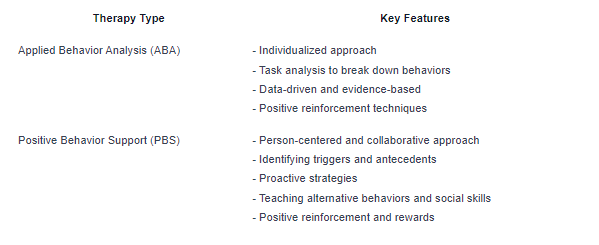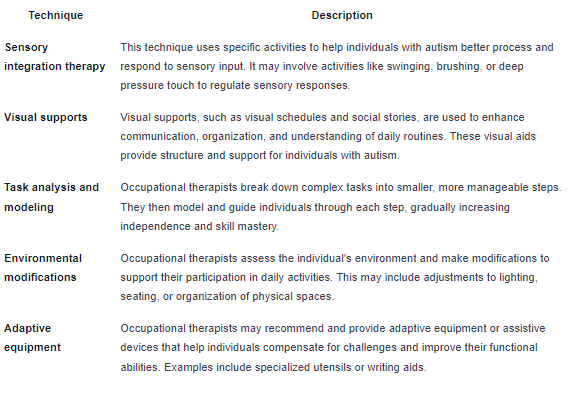8 Types of Therapy for Autism To Consider
Discover 8 vital therapy types for autism, from behavioral therapy to social skills training. Find the support your loved ones need!

Understanding Autism and Therapy
To embark on the journey of helping individuals with autism spectrum disorder (ASD), it is crucial to have a comprehensive understanding of the condition and the role that therapy plays in its treatment. This section provides an overview of autism spectrum disorder and highlights the importance of therapy in autism treatment.
Overview of Autism Spectrum Disorder
Autism spectrum disorder is a neurodevelopmental condition characterized by challenges in social interaction, communication, and restricted or repetitive behaviors. It is a spectrum disorder, meaning that it manifests differently in each individual, ranging from mild to severe. ASD affects people of all races, ethnicities, and socioeconomic backgrounds, with a higher prevalence in males.
The symptoms of autism spectrum disorder typically emerge in early childhood, although they may be recognized later in life. Some common signs include difficulty with social interactions, delayed or atypical language development, repetitive movements or behaviors, and sensory sensitivities. It is important to note that each person with ASD is unique, and their strengths and challenges may vary.
Importance of Therapy in Autism Treatment
Therapy plays a vital role in the treatment and management of autism spectrum disorder. It aims to address the core symptoms of ASD, improve communication and social skills, manage challenging behaviors, and enhance overall quality of life for individuals with autism.
The goal of therapy is to provide individuals with the tools and strategies they need to navigate the challenges associated with ASD. It is important to tailor therapy approaches to meet the specific needs of each individual, taking into account their strengths, weaknesses, and personal goals. Therapy can be highly effective in improving functional abilities, independence, and overall well-being.
There are several types of therapy available for individuals with autism spectrum disorder, each targeting different areas of development and addressing specific challenges. These therapies include behavioral therapy, communication therapy, sensory integration therapy, occupational therapy, social skills therapy, and family therapy. By utilizing a combination of these therapies, individuals with autism can experience significant progress and improvement in various aspects of their lives.
By understanding the fundamentals of autism spectrum disorder and recognizing the importance of therapy, individuals, families, and healthcare professionals can work together to provide the best possible care and support for those with autism. Through early intervention and ongoing therapy, individuals with autism can thrive, reach their full potential, and lead fulfilling lives.
Behavioral Therapy
Behavioral therapy plays a crucial role in the treatment of individuals with autism. It focuses on modifying and shaping behaviors to improve social skills, communication, and overall functioning. Two prominent types of behavioral therapy for autism are Applied Behavior Analysis (ABA) and Positive Behavior Support (PBS).
Applied Behavior Analysis (ABA)
Applied Behavior Analysis (ABA) is a widely recognized and evidence-based therapy for autism. It applies principles of learning and behavior to analyze and modify behaviors. ABA therapy is highly individualized, targeting specific behaviors and working towards meaningful goals.
One of the key components of ABA is breaking down desired behaviors into smaller, manageable steps. This process, known as task analysis, allows for systematic teaching and reinforcement. ABA therapists use positive reinforcement techniques to encourage and strengthen desired behaviors while minimizing or eliminating challenging behaviors.
ABA therapy is data-driven, with therapists collecting and analyzing data to track progress and make informed decisions. This data-driven approach enables therapists to make adjustments to the intervention strategies as needed, ensuring the therapy is tailored to the unique needs of each individual.
Positive Behavior Support (PBS)
Positive Behavior Support (PBS) is a person-centered and collaborative approach aimed at promoting positive behaviors and reducing challenging behaviors in individuals with autism. PBS focuses on understanding the reasons behind behaviors and implementing effective strategies to support positive change.
PBS involves a team of professionals working together to develop an individualized behavior support plan. This plan identifies the triggers, antecedents, and consequences of behaviors and provides strategies to teach and reinforce appropriate behaviors. The goal of PBS is to create a supportive environment that promotes positive behaviors and enhances quality of life.
Unlike ABA, PBS emphasizes proactive strategies rather than reactive ones. It focuses on teaching individuals alternative behaviors and social skills to replace challenging behaviors. PBS also encourages the use of positive reinforcement and rewards to motivate and reinforce desired behaviors.
Both ABA and PBS are effective therapies for addressing challenging behaviors and promoting positive development in individuals with autism. The choice between the two depends on individual needs and preferences, and it's essential to consult with professionals to determine the most suitable therapy approach.

Communication Therapy
Communication therapy plays a vital role in the treatment of individuals with autism spectrum disorder. It helps to enhance communication skills, improve social interactions, and facilitate better understanding of language. There are different types of communication therapy available, including speech therapy and augmentative and alternative communication (AAC).
Speech Therapy
Speech therapy focuses on improving speech and language skills in individuals with autism. It is designed to address challenges related to articulation, fluency, voice, and language development. Speech therapists work closely with individuals to assess their specific needs and develop tailored treatment plans.
During speech therapy sessions, various techniques and exercises are used to improve communication abilities. These may include:
- Articulation exercises: Targeting specific speech sounds to improve clarity and pronunciation.
- Language development activities: Enhancing vocabulary, grammar, and comprehension skills.
- Social communication skills training: Facilitating better understanding and use of nonverbal cues, turn-taking, and conversation skills.
The ultimate goal of speech therapy is to help individuals with autism communicate effectively and confidently, enabling them to express their thoughts, needs, and emotions.
Augmentative and Alternative Communication (AAC)
Augmentative and Alternative Communication (AAC) is another form of communication therapy that supports individuals who struggle with verbal speech or have limited communication abilities. AAC encompasses various methods, strategies, and tools to enhance communication.
AAC systems can range from low-tech options, such as picture boards or communication books, to high-tech devices, including speech-generating devices and specialized software applications. These systems enable individuals with autism to express themselves through visual aids, gestures, sign language, or electronic devices.
AAC offers individuals with limited verbal speech the opportunity to communicate effectively and participate in social interactions. It is often tailored to the individual's specific needs and abilities, ensuring that they can engage with the world around them.
In summary, communication therapy, including speech therapy and augmentative and alternative communication (AAC), plays a crucial role in improving communication skills and enhancing the quality of life for individuals with autism. By addressing speech and language difficulties, these therapies empower individuals to express themselves, connect with others, and navigate the world more effectively.
Sensory Integration Therapy
Sensory Integration Therapy is a type of therapy that focuses on addressing the sensory processing challenges faced by individuals with autism. This therapy aims to help individuals better understand and respond to sensory information in their environment. By providing structured sensory experiences, sensory integration therapy helps individuals develop appropriate responses and improve their overall sensory processing abilities.
How Sensory Integration Therapy Works
Sensory Integration Therapy involves the use of various sensory activities to target specific sensory processing difficulties. These activities are tailored to the individual's needs and may include play-based exercises, movement-based activities, and exposure to different sensory stimuli. The therapy is typically conducted by trained occupational therapists who create a safe and supportive environment for the individual.
During sensory integration therapy sessions, individuals are exposed to different sensory experiences that challenge their sensory systems. This may include activities such as swinging, jumping, balancing, and playing with different textures. The therapist carefully observes the individual's responses and provides guidance to help them regulate their sensory reactions and develop appropriate coping strategies.
Benefits of Sensory Integration Therapy
Sensory Integration Therapy offers several benefits for individuals with autism. By targeting sensory processing challenges, this therapy can help improve various aspects of daily life. Some of the benefits of sensory integration therapy include:
- Improved sensory processing: Sensory integration therapy helps individuals develop more efficient sensory processing abilities, allowing them to better understand and respond to sensory information.
- Enhanced motor skills: Through movement-based activities, sensory integration therapy helps individuals improve their coordination, balance, and motor planning skills.
- Increased attention and focus: By providing structured sensory experiences, sensory integration therapy can help individuals improve their attention and focus, leading to better engagement in daily activities.
- Reduction in sensory sensitivities: Sensory integration therapy aims to desensitize individuals to certain sensory stimuli, reducing their sensory sensitivities and improving their tolerance to different environments.
- Better self-regulation: With regular sensory integration therapy, individuals can develop effective self-regulation strategies, allowing them to manage sensory challenges more independently.
Overall, sensory integration therapy plays a vital role in addressing sensory processing difficulties in individuals with autism. By providing targeted sensory experiences and promoting adaptive responses, this therapy can significantly improve the everyday lives of individuals on the autism spectrum.
Occupational Therapy
Occupational therapy plays a vital role in the comprehensive treatment of individuals with autism spectrum disorder (ASD). This therapy focuses on improving an individual's ability to participate in daily activities and develop essential life skills. In this section, we will explore the goals of occupational therapy and the techniques used to achieve them.
Goals of Occupational Therapy
Occupational therapy for individuals with autism aims to address specific challenges and promote independence in various areas of daily life. Some common goals of occupational therapy for individuals with autism include:
- Self-care skills: Occupational therapy helps individuals develop and refine self-care skills such as dressing, grooming, and feeding themselves. These skills are essential for fostering independence and enhancing overall quality of life.
- Fine motor skills: Occupational therapy focuses on improving fine motor skills, which involve precise movements of the hands and fingers. Enhancing fine motor skills helps individuals with tasks such as writing, using utensils, and manipulating small objects.
- Gross motor skills: Occupational therapy also targets gross motor skills, which involve larger muscle groups and coordination. Developing these skills enhances balance, coordination, and physical abilities for activities like running, jumping, and playing sports.
- Sensory processing: Occupational therapy addresses sensory challenges commonly experienced by individuals with autism. It helps individuals regulate their responses to sensory input, such as touch, sound, and visual stimuli, enabling them to better adapt to their environment.
- Play and social skills: Occupational therapists work on promoting play and social skills, which are crucial for building relationships and interacting with peers. This includes teaching turn-taking, sharing, and engaging in cooperative play.
Techniques Used in Occupational Therapy
Occupational therapists employ various techniques and interventions to help individuals with autism achieve their therapy goals. Some commonly used techniques in occupational therapy for autism include:

Occupational therapy is a valuable component of a comprehensive treatment plan for individuals with autism. By addressing specific goals and utilizing effective techniques, occupational therapists help individuals develop essential skills and enhance their overall functioning in daily life.
Social Skills Therapy
For individuals with autism, social skills therapy plays a crucial role in developing and enhancing their ability to interact and communicate with others effectively. It focuses on improving social interactions, understanding social cues, and developing appropriate social behaviors. In this section, we will explore two types of social skills therapy: social skills training programs and group therapy for social skills development.
Social Skills Training Programs
Social skills training programs are structured interventions designed to teach individuals with autism specific social skills and behaviors. These programs typically involve a combination of individual and group sessions, using evidence-based techniques and strategies to target various social challenges.
These programs aim to address specific areas of social difficulty, such as initiating conversations, maintaining eye contact, understanding nonverbal cues, and developing empathy. Through structured activities, role-playing exercises, and behavioral modeling, individuals with autism can learn and practice these skills in a supportive and controlled environment.
The duration and intensity of social skills training programs may vary depending on the individual's needs and goals. It is often recommended to participate in ongoing programs to reinforce learned skills and promote generalization to real-life social situations.
Group Therapy for Social Skills Development
Group therapy for social skills development involves individuals with autism coming together in a supervised group setting to work on improving their social skills. These groups provide a supportive and inclusive environment where participants can practice social interactions, engage in cooperative activities, and learn from one another.
Group therapy sessions are typically led by trained professionals who facilitate structured social activities and guide participants through social skill-building exercises. These sessions may focus on various areas, including initiating and maintaining conversations, sharing and turn-taking, problem-solving, and perspective-taking.
The benefits of group therapy for social skills development go beyond skill acquisition. Participants also have the opportunity to form friendships, gain a sense of belonging, and develop self-confidence in social settings. By interacting with peers who face similar challenges, individuals with autism can learn from shared experiences and build a sense of community.
In summary, social skills therapy, through social skills training programs and group therapy, is an essential component of autism treatment. These therapies provide individuals with autism the necessary tools and support to navigate social interactions successfully. By focusing on skill development and fostering peer connections, social skills therapy promotes social inclusion, communication, and overall well-being.
Family Therapy
Involving Families in Autism Therapy
Family therapy plays a crucial role in the treatment of autism spectrum disorder (ASD). It recognizes the importance of involving the entire family in the therapeutic process, as they are integral to the well-being and development of individuals with autism.
In family therapy, the focus extends beyond the individual with autism to address the needs and challenges faced by the entire family unit. The goal is to improve communication, strengthen relationships, and provide support and guidance to family members. By involving families in autism therapy, it creates a collaborative and supportive environment that enhances the overall effectiveness of treatment.
Some key strategies used in family therapy for autism include:
- Psychoeducation: Providing families with information and resources about autism, its characteristics, and available treatment options. This helps families gain a better understanding of their loved one's condition and empowers them to actively participate in their care.
- Parental Involvement: Engaging parents as active participants in therapy sessions, equipping them with strategies and techniques to support their child's development, and promoting positive parenting skills. This involvement fosters a sense of empowerment and confidence in parents, enabling them to effectively navigate the challenges associated with autism.
- Collaborative Problem-Solving: Working together with families to identify specific issues or challenges they may be facing and developing strategies to address them. This collaborative approach encourages open communication, problem-solving, and shared decision-making within the family unit.
- Emotional Support: Providing emotional support to family members, as caring for a child with autism can be emotionally demanding. Family therapy creates a safe space for family members to express their feelings, share their experiences, and receive guidance and validation.
Benefits of Family Therapy in Autism Treatment
Family therapy offers numerous benefits in the treatment of autism. It recognizes that the well-being of individuals with autism is intertwined with the well-being of their families. Here are some key benefits:
Benefits
Enhanced communication within the family
Strengthened family relationships and dynamics
Improved understanding of autism and its impact on the family
Increased parental confidence in managing their child's needs
Development of effective coping strategies for family members
Decreased stress levels for parents and other family members
Promotion of a supportive and inclusive family environment
Improved implementation of therapy techniques at home
By involving families in the therapeutic process, family therapy nurtures a holistic and comprehensive approach to autism treatment. It recognizes that the support, understanding, and active participation of family members are essential in helping individuals with autism reach their full potential.
Sources
https://www.songbirdcare.com/articles/types-of-therapy-for-autism
https://www.totalcareaba.com/autism/types-of-therapy-for-autism
https://www.crossrivertherapy.com/autism/types-of-therapy-for-autism
Similar articles
We’re here to help you

Our team is here to assist you in this process. Contact us for any assistance.
it’s easy to apply
We Accept Most Insurances
Our in-network insurance partnerships make ABA therapy more accessible to families throughout our service areas.







Our Insurance Process
We'll request your insurance details to help us verify your plan's coverage for ABA therapy. Once we've received this information, we'll walk you through your benefits, including copayments, deductibles and out-of-pocket maximums, so you know what to expect in advance.
Our team will then handle the preauthorization and all the necessary paperwork.
.svg)





















.jpeg)


































.jpeg)




.jpeg)







.jpeg)











.jpeg)
















